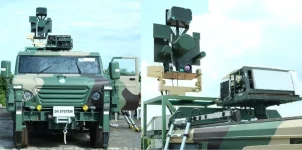- Views: 1K
- Replies: 10
The Indian Air Force (IAF) is advancing a two-part strategy to significantly boost its long-range precision strike capabilities.
The plan involves the domestic production of the proven Israeli Rampage missile alongside the development of an air-launched version of the indigenous Pinaka-IV rocket system, aiming to enhance both immediate operational readiness and long-term self-reliance in national defence.
Localising a Proven Weapon
Following the reported effective use of the Israeli-designed Rampage missile in recent conflicts, the IAF is moving to have the weapon manufactured in India.The Rampage is a supersonic, air-to-ground missile with a range of approximately 250 kilometres, capable of carrying a 150 kg warhead to destroy high-value, protected targets.
Reports indicate the missile was successfully deployed from the IAF's Sukhoi-30 MKI and Rafale fighter jets, reinforcing its value as a critical standoff asset.
In line with the government's 'Aatmanirbhar Bharat' (Self-Reliant India) policy, an agreement has reportedly been reached with Israel for licensed production.
This initiative will see an Indian defence company, possibly a state-owned enterprise like Bharat Dynamics Limited (BDL) or a private firm, collaborate with Israel Aerospace Industries (IAI).
This move is expected to ensure a consistent supply of the missiles, lower procurement costs, improve maintenance and support within the country, and integrate Indian industry into the weapon's global supply chain. Production facilities for the missile are anticipated to be established by mid-2026.
Developing an Indigenous Standoff Solution
Concurrently, the Defence Research and Development Organisation (DRDO) is working on an ambitious project to create an air-launched variant of its Pinaka-IV rocket.The Pinaka is a multi-barrel rocket launcher system that has been a cornerstone of the Indian Army's artillery. The upcoming ground-launched Pinaka-IV is being designed to strike targets at distances between 250 and 300 kilometres.
DRDO has proposed adapting this system for the IAF, creating a long-range cruise missile that can be fired from fighter jets. This would provide a cost-effective, domestically produced weapon for engaging targets deep inside enemy territory, keeping IAF aircraft safely outside the range of hostile air defence systems.
The air-launched Pinaka-IV is planned to be compatible with a wide range of IAF fighters, including the Su-30 MKI, Rafale, Mirage 2000, and the indigenous Tejas LCA, offering significant operational flexibility.
Strategic Goals and Technical Path Forward
This dual approach allows the IAF to diversify its arsenal. The local production of the Rampage provides a combat-tested and reliable weapon for immediate needs, while the development of the airborne Pinaka-IV represents a strategic investment in India's own defence industrial base.To make the Pinaka-IV suitable for aerial launch, DRDO will need to address technical challenges, including modifying the rocket's structure for flight stability and integrating advanced guidance systems for precision accuracy at long ranges.
However, DRDO's extensive experience with the Pinaka family and other advanced missile programs like the Rudram provides a strong foundation for success.
The push for advanced Pinaka systems is also supported by the Indian Army, which is seeking newer variants to modernise its own long-range firepower.
The successful adaptation of this ground-based system for the air force would mark a major achievement in creating versatile, multi-platform weapon systems within India.




